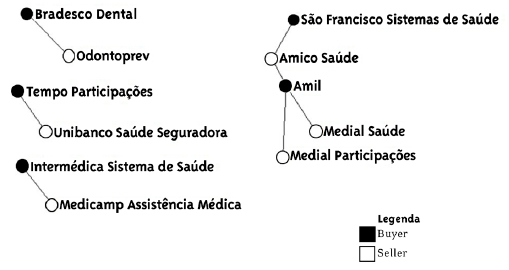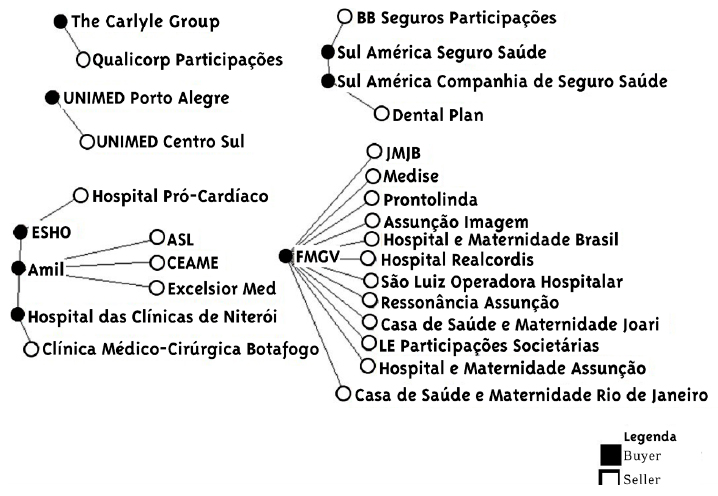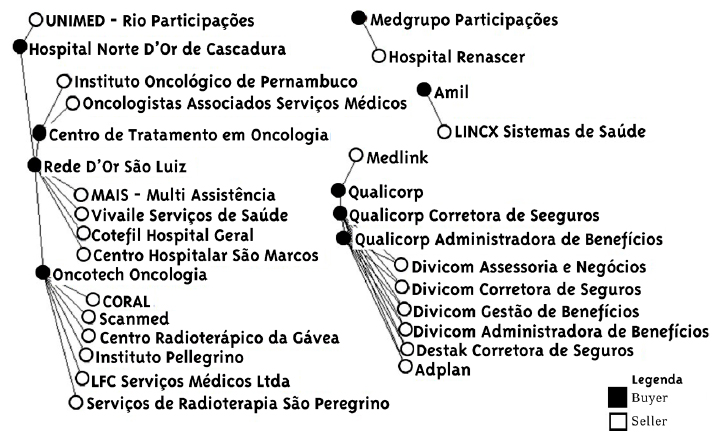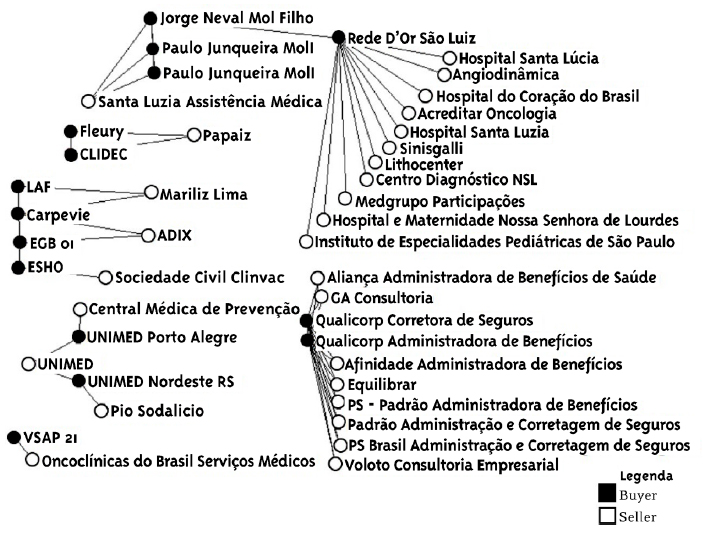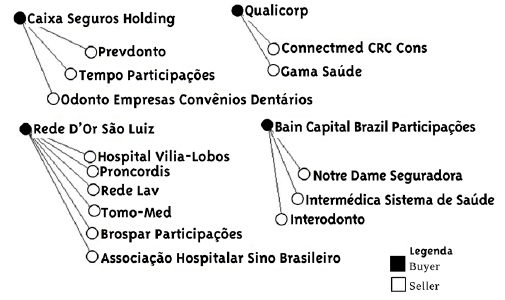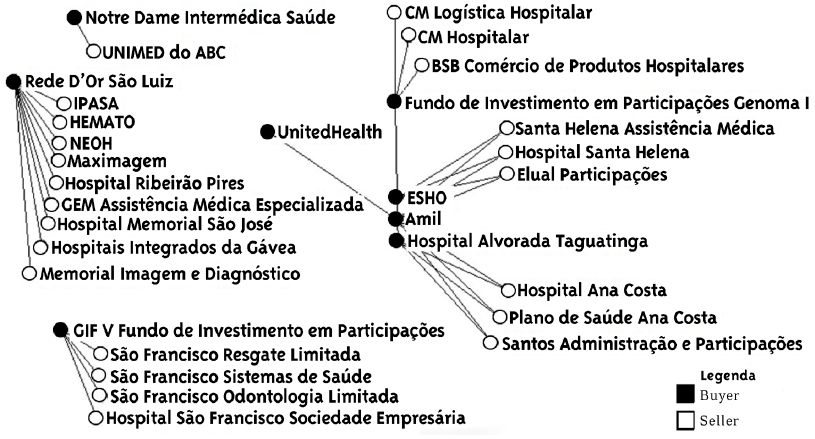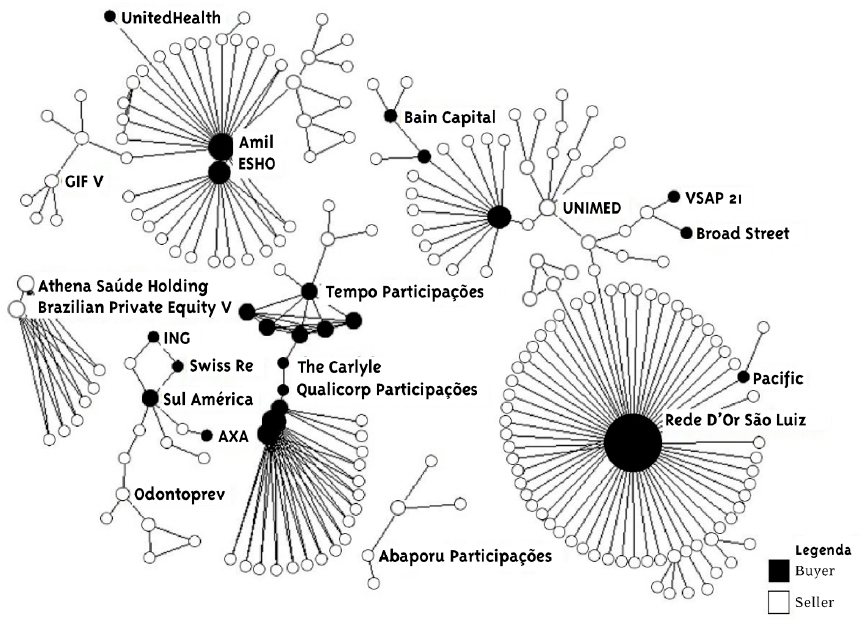Abstract
The promulgation of Law No. 13,097 / 15 extended the possibility of the participation of foreign companies in the health area in Brazil, until then accessible to some sectors, such as supplementary health. In this context, this paper seeks to characterize the dynamics of the networks of operations of economic concentration acts in hospitals and health plans in Brazil. For such purpose, data were collected from the processes available on the website of the Administrative Council for Economic Defense (CADE), organized from the corporate structure, originated by investors (foreign or national) and analyzed using network analysis software. In data analysis, 93 acts of economic concentration were identified from 2009 to 2017, the participation of 12 foreign companies with predominant origin from the United States of America. These acts of concentration evidenced the formation of a robust network composed of three economic groups with predominantly foreign corporate control and a latent need to establish policies to analyze the risks and benefits of this new reality to the Brazilian health market. In another scenario, potential reflexes in the Brazilian health system will be fortunate.
Keywords:
Health; Concentration Acts; Network
Introduction
Financing and provision of health goods and services are carried out by public and private sectors in Brazil’s healthcare system, characterizing it as a mixed system (Andrade et al. 2015ANDRADE, M. V. et al. Estrutura de concorrência no setor de operadoras de planos de saúde no Brasil. Brasília, DF: Opas, 2015.).
This public-private relationship that provides healthcare services to Brazilian citizens is defined in article 197 of the 1988 Constitution (Brasil, 1988BRASIL. [Constituição (1988)]. Constituição da República Federativa do Brasil de 1988. Brasília, DF: Presidência da República, 2016 [1988]. Disponível em: <Disponível em: https://www.planalto.gov.br/ccivil_03/constituicao/constituicao.htm >. Acesso em: 6 jun. 2018.
https://www.planalto.gov.br/ccivil_03/co... ), even though this same Constitution defines health as a public, free and universal right, expanding the complexity of the system. In this context, given the private sector participation in healthcare services and due to this duality, over the last few years a relationship initially based on a “right” has become increasingly conflicting, and the right has turned into a “product.” One of the main issues of this complex industrial organization with peculiar characteristics, compared to other markets, is how financing takes pace.
In general terms, public policies related to healthcare financing are established, at times, for the benefit of the public sector and, at others, for the benefit of the private sector or, even, covered by reciprocal benefits, under the allegation that public and private services are precarious (Brasil, 2014BRASIL. Senado Federal. Comissão Mista da MPV 656/2014. Parecer técnico nº44, de 2014-CN. Brasília, DF, 2014. Disponível em: <Disponível em: http://www.camara.gov.br/proposicoesWeb/prop_mostrarintegra?codteor=1293518&filename=Tramitacao-PAR+44+MPV65614+%3D%3E+MPV+656/2014 >. Acesso em: 6 jun. 2018.
http://www.camara.gov.br/proposicoesWeb/... ). Faced with a precarious public healthcare system, which is unable to provide comprehensive and universal quality care, a favorable space is opened for a number of possibilities for the expansion of the private sector (Zocratto, 2014ZOCRATTO, K. B. F. Mercado da saúde: uma análise da oferta e demanda. Revista da AMDE, Belo Horizonte, v. 12, n. 1, p. 154-164, 2014.). Specifically regarding how the healthcare sector financing takes place, two examples of public policies can be highlighted. The first is related to the supplementary health insurance market, and the second refers to the hospital market in general, and both have participation of foreign capital in common.
Soon after the structuring of the supplementary health insurance market, in 1998, by Law No. 9.656 (Brasil, 1998BRASIL. Lei nº 9.656, de 3 de junho de 1998. Dispõe sobre os planos e seguros privados de assistência à saúde. Diário Oficial da União: Brasília, DF, 3 jun. 1998. Disponível em: <Disponível em: http://www.planalto.gov.br/ccivil_03/Leis/L9656.htm >. Acesso em: 6 jun. 2018.
http://www.planalto.gov.br/ccivil_03/Lei... ), a little more than 10 years after the promulgation of the Constitution, Provisional Measure No. 1.908-18/99 (Brasil, 1999BRASIL. Medida Provisória nº 1.908-18, de 24 de setembro de 1999. Altera a Lei no 9.656, de 3 de junho de 1998 […], e dá outras providências. Diário Oficial da União , Brasília, DF, 4 set. 1999. Disponível em: <Disponível em: http://www.planalto.gov.br/ccivil_03/mpv/Antigas/1908-18.htm >. Acesso em: 6 jun. 2018.
http://www.planalto.gov.br/ccivil_03/mpv... ) introduced the possibility of foreign companies investing in health insurance providers. The 1988 Constitution (Brasil, 1988BRASIL. [Constituição (1988)]. Constituição da República Federativa do Brasil de 1988. Brasília, DF: Presidência da República, 2016 [1988]. Disponível em: <Disponível em: https://www.planalto.gov.br/ccivil_03/constituicao/constituicao.htm >. Acesso em: 6 jun. 2018.
https://www.planalto.gov.br/ccivil_03/co... ), in its article 199, established the need for specific legislation for this case, which was, therefore, defined by the aforementioned Provisional Measure and later solidified in Provisional Measure No 2.177-44/01 (Brasil, 2001BRASIL. Medida Provisória nº. 2177-44, de 24 de agosto de 2001. Altera a Lei no 9.656 […] e dá outras providências. Diário Oficial da União , Brasília, DF, 24 ago. 2001. Disponível em: <Disponível em: http://www.planalto.gov.br/ccivil_03/mpv/2177-44.htm >. Acesso em: 6 jun. 2018.
http://www.planalto.gov.br/ccivil_03/mpv... ). The definition of this policy generated an anomaly in the healthcare sector, since, although there was specific legislation via provisional measure, there was also an express prohibition on the foreign investors’ participation in this sector, as established in article 23 of Law No. 8.080, of 1990 (Brazil, 1990BRASIL. Lei nº 8.080, de 19 de setembro de 1990. Dispõe sobre as condições para a promoção […] e dá outras providências. Diário Oficial da União , Brasília, DF, 19 set. 1990. Disponível em: <http://www.planalto.gov.br/ccivil_03/LEIS/L8080.htm>. Acesso em: 6 jun. 2018.).
In this context, as clarified by document No. 002 of the Federal Attorney General’s Office, of 2008, (PGF, 2008PGF - PROCURADORIA GERAL FEDERAL. Informação nº. 002/2008/PROGE/GECOS. Rio de Janeiro, 2008. Disponível em: <Disponível em: http://www.agu.gov.br/page/download/index/id/1550906 >. Acesso em: 18 jun. 2018.
http://www.agu.gov.br/page/download/inde... ), it would be possible, for example, the existence of a foreign investor in a supplementary health insurance provider, which, in turn, could own a hospital in its own network, but there could be no hospitals that had the direct participation of foreign investment. This nonsense was maintained until 2015, when the aforementioned article 23 of Law No. 8.080 was amended by Law No. 13.097 (Brasil, 2015BRASIL. Lei nº 13.097, de 19 de janeiro de 2015. Reduz a zero as alíquotas da Contribuição para o PIS/PASEP […]; e dá outras providências. Diário Oficial da União: Brasília, DF, 19 jan. 2015. Disponível em: <Disponível em: https://www.planalto.gov.br/ccivil_03/_ato2015-2018/2015/lei/l13097.htm >. Acesso em: 18 jun. 2018.
https://www.planalto.gov.br/ccivil_03/_a... ), allowing the unrestricted action of foreign investors in the Brazilian healthcare market.
This scenario of market opening to foreign investors and the growth of interest in the healthcare market on a global scale boosted operations involving economic concentration acts in health insurance providers and hospitals in the country, as evidenced by Andrade et al. (2015ANDRADE, M. V. et al. Estrutura de concorrência no setor de operadoras de planos de saúde no Brasil. Brasília, DF: Opas, 2015.) and Menezes (2019MENEZES, J. P. C. B. Fusões e aquisições, concorrência e concentração: investimento estrangeiro em saúde suplementar no Brasil. Tese (Doutorado em Administração) - Faculdade de Ciências Econômicas, Universidade Federal de Minas Gerais, Belo Horizonte, 2019.). Through economic concentration acts, private healthcare companies can organize themselves in a network in order to explore market opportunities, reduce costs, facilitate the allocation of resources and expand their boundaries of operation. On the other hand, they can build anti-competitive structures that harm the market. Aiming at characterizing the dynamics of the networks of economic concentration acts in hospitals and health insurance providers in Brazil, this work was based on the following question: what are the characteristics of the dynamics of the network of concentration acts occurred from 2009 to 2017 in the health insurance sector and the hospital sector in Brazil?
For this purpose, data from 2009 to 2017 were collected in the processes available on the Administrative Council for Economic Defense (Cade) website, organized based on the investors’ corporate structure and origin (foreign or national) and analyzed using software for network analysis, specifically Ucinet and NetDraw. Based on this analysis, it was possible to present an evolutionary map of the operations carried out over these years, determining the predominant economic groups, their origin and the peculiar characteristics of each of the transactions.
Material and Methods
This is a descriptive study, with a quantitative approach, using secondary data collected based on volumes of processes available on Cade’s website. The data and information on concentration acts and companies involved were extracted from the volumes of processes systematically obtained as follows: on Cade’s website, in the section Pesquisa Processual [Procedural Research], one searched for the terms “hospital” and “health,” establishing the period from January 1, 2009 to December 31, 2017, and with the following items selected: processes; generated documents and external documents; if the process was primary; and summary concentration act (simplified decision process) and ordinary concentration act (decision process with detailed analysis).
Summary concentration acts present the greatest offensive potential to competitors, given the simplicity of the operations; in turn, ordinary acts are the most offensive to competition and with a greater degree of operation complexity (Cade, 2012CADE - CONSELHO ADMINISTRATIVO DE DEFESA ECONÔMICA. Resolução nº 2, de 29 de maio de 2012. Disciplina a notificação dos atos de que trata o artigo 88 da Lei no 12.529, de 30 de novembro de 2011, prevê procedimento sumário de análise de atos de concentração e dá outras providências. 2012. Disponível em: <Disponível em: http://www.cade.gov.br/assuntos/normas-e-legislacao/resolucao/resolucao-2_2012-analise-atos-concentracao.pdf/view >. Acesso em: 30 set. 2017.
http://www.cade.gov.br/assuntos/normas-e... ). “Concentration acts are justified, from a business point of view, by the prospect of exploring economic and financial synergies between companies and by the expectation of greater surpluses for applicants after the transaction” (Cade, 2016CADE - CONSELHO ADMINISTRATIVO DE DEFESA ECONÔMICA. Guia para análise de atos de concentração horizontal. Brasília: Departamento de Estudos Econômicos, 2016. Disponível em: <Disponível em: https://cdn.cade.gov.br/Portal/centrais-de-conteudo/publicacoes/guias-do-cade/guia-para-analise-de-atos-de-concentracao-horizontal.pdf?_ga=2.6482610.1685238981.1610628269-285367626.1598541266 >. Acesso em: 14 jan. 2021.
https://cdn.cade.gov.br/Portal/centrais-... , p. 45).
The data collected were organized in spreadsheets and the analysis of the network dynamics was performed using Ucinet software package and the NetDraw network visualization tool. For the analysis of Network Dynamics, the database was formed by 211 companies and three individuals that performed economic concentration acts in Brazil from 2009 to 2017 involving hospitals and/or health insurance providers. Although it was not the scope of this work to address aspects related to the Decision Units Theory, proposed by Hermann and Hermann (1989HERMANN, M. G.; HERMANN, C. F. Who makes foreign policy decisions and how: an empirical inquiry. International Studies Quarterly, Oxford, v. 33, n. 4, p. 361-387, 1989.), the actors were initially treated as operational units, and later the decision units were identified through nodes, which in turn control the operating units in their link. For network characterization, the indicators were calculated for density, average distance, degree centrality and betweenness centrality, described by Alejandro and Norman (2005), as shown in Chart 1.
For the indicator calculation on Ucinet and generation of charts on NetDraw, binary relational matrices were created in spreadsheets. The construction of these relational matrices is exemplified as follows: in cell A3, if company X (column) had performed an economic concentration act with company Y (row), cell A3 was indicated with the number 1. Otherwise, the number zero was indicated.
By analyzing the dynamics of networks of 211 companies and three individuals, it was possible to define the main actors involved in the operations and their connections, with a network having two main elements, the “nodes” (or actors) and the link. Nodes/actors are people or groups of people that come together with a common goal. The link is the ties that exist between two or more nodes/actors, which are represented by lines (Ghiradini, 2015GHIRADINI, P. P. B. Regressão diferenças em diferenças: uma análise de fusões no setor hospitalar brasileiro. 2015. Dissertação de Mestrado (Mestrado em Economia) - Faculdade de Economia, Administração, Contabilidade e Ciência da Informação e Documentação, Universidade de Brasília, Brasília, DF, 2015.).
In this research, the “nodes” are the companies and the links are the concentration acts that occurred between hospitals and/or health insurance providers from 2009 to 2017, whose operations were submitted to Cade’s assessment. Companies that are part of the same economic group are also characterized as a link. In this way, a line between two actors (companies) shows that they participated in the same concentration act or are part of the same economic group. For example, in Figure 1, there was an economic concentration act between Bradesco Dental and Odontoprev, which established a link between these companies; in turn, Amil and Amico have a connection, since Amico is part of Amil.
With regard to the colors adopted on the maps, black indicates “buying” companies, that is, those that acquired a shareholding/portfolio in other companies or carried out the request for the operation with Cade, configuring themselves as the most interested in performing the operation; white indicates “selling” companies, that is, those that were selling shares, portfolio or issuing debentures, and called “object of the operation” by Cade in the volumes of the processes; finally, black, in Figure 11, indicates foreign companies. After the initial clarifications, results and discussions are presented below.
Results and discussions
One hundred economic concentration acts were identified in hospitals and health insurance providers in Brazil from 2009 to 2017; those with no consummation by the companies and those rejected and not recognized by Cade have been removed, with a total of 93 acts being reached. The highest number of operations occurred in 2010, 2012 and 2015. In 2009, the lowest number of operations was registered - five -, as shown in Table 1.
It was found that most operations performed from 2009 to 2017, 79 (85%), were approved by Cade without restrictions, and 14 (15%) approved with restrictions, a factor that can favor increased economic concentration in the health sector. Economic concentration acts strengthen a company, as these operations bring advantages, such as cost reduction, infrastructure expansion and increased profits (Hitt; Ireland; Harrison, 2001HITT, M. A.; IRELAND, R. D.; HARRISON, J. S. Mergers & acquisitions: a guide to creating value for stakeholders. Oxford: Oxford University Press, 2001.).
When verifying the origin of the companies involved in the operations, most were concentrated in the state of São Paulo (49%), followed by Rio de Janeiro (22%), and Pernambuco (10%). Based on this information, it can be seen that the companies that most participated in economic concentration acts in the period studied were located in the Southeast region (72%).
In 2009, there were five economic concentration acts, four approved without restrictions by Cade, and one with restrictions. Two were classified as ordinary and three as summary. As for the type of operation, there were three shareholding acquisitions, one portfolio acquisition and one merger, which involved 11 companies, as shown in Figure 1.
One operation stood out in 2009, when Amil Assistência Médica Internacional, a health and dental insurance provider, acquired shareholdings in two companies, Medial Participações and Medial Saúde, which also operated as health and dental insurance providers.
When analyzing the year 2010, it was noticed that the number of economic concentration acts more than doubled when compared to 2009, jumping from five to 13. There were 10 operations approved without restrictions by Cade, and three approved with restrictions, four classified as ordinary and nine as summary, and all operations were shareholding acquisitions. In Figure 2, it is possible to verify that 29 companies were involved.
FMG Empreendimentos Hospitalares was involved in five economic concentration acts with 12 companies in 2010, as shown in Figure 2. Also in 2010, it is possible to note that there were foreign investments in the country, when The Carlyle Group, a globally active US asset management holding company, acquired a shareholding in Qualicorp Participações, which operates as a collective health insurance provider.
Amil Assistência Médica Internacional was the only company to carry out economic concentration acts in 2009 and 2010, expanding its operation to five companies, namely: ASL Assistência à Saúde, Ceame - Centro Especializado de Atendimento Médico, Excelsior Med, Medial Saúde and Medial Participações. From these acquisitions, Amil Assistência Médica Internacional expanded its operation in the states of Pernambuco, Rio Grande do Norte and São Paulo.
There were 12 economic concentration acts in 2011, eight approved without restrictions by Cade, and four with restrictions. All were classified as summary operations, with 10 shareholding acquisitions and two assignments of rights, involving 31 companies, as shown in Figure 3.
Qualicorp, Qualicorp Corretora de Seguros and Qualicorp Administratora de Benefícios were part of the Grupo Qualicorp - acquired in 2010 by The Carlyle Group -, and carried out three operations in 2011 involving seven companies, expanding its operation in health insurance activities in the states of Rio de Janeiro and São Paulo.
Also in 2011, Rede D’Or São Luiz, a group of companies that provide hospital services, carried out three operations involving five companies; Oncotech Oncologia, one of those companies, also performed an operation with six companies in hospital activities, expanding activities in the states of Rio de Janeiro and Rondônia. Two companies that already belonged to Grupo Rede D’Or São Luiz, namely, Hospital Norte D’Or de Cascadura and Centro de Tratamento em Oncologia, performed two operations. Hospital Norte D’Or de Cascadura acquired a shareholding in Unimed-Rio Participações e Investimentos, which is part of Rede de Cooperativas Unimed.
In 2012, 15 operations were registered, six approved without restrictions by Cade, and nine with restrictions. As for classification, four operations were classified as ordinary and 11 as summary. As for the type, there were two portfolio acquisitions, 11 shareholding acquisitions, one assignment of rights and one issuance of debentures, involving 42 companies as shown in Figure 4.
During the period analyzed, the health insurance providers and hospitals carried out economic concentration acts with companies performing several activities, expanding the portfolio of services and products, which indicates search for a greater vertical integration.
Also in 2012, the companies previously controlled by Edson de Godoy Bueno, LAF - - Empresa de Serviços Hospitalares; Carpevie - Centro de Medicina Integrada; EGB 01 Empreendimentos e Participações, and ESHO - Empresa de Serviços Hospitalares, performed three operations.
It is worth noting that, in 2012, foreign investments were made through an operation in which Oncoclínicas do Brasil Serviços Médicos issued debentures to the Canadian VSAP 21 Fundo de Investimento em Participações - which operates acquiring shares, debentures, subscription bonuses and other securities in other companies, in accordance with the interest of their shareholders - and is part of Victoria Capital Partners Group.
In 2013, there were 10 operations, all approved without restrictions by Cade, with three classified as ordinary and seven as summary. As for the type, there were four portfolio acquisitions, four shareholding acquisitions and two mergers, which involved 20 companies, as shown in Figure 5.
In 2013, Rede de Cooperativas Unimed stood out for being involved in 50% of the operations. It made four portfolio acquisitions and one merger. Unimed Odonto carried out two operations, acquiring Unimed Vitória’s and Unimed Recife’s dental insurance portfolios. Even after the operation, Unimed Vitória and Unimed Recife continued to exist in the health insurance market, except for dental insurance.
The UnitedHealth Group, from the United States, which operates in health insurance and provision of medical and hospital services, acquired control of Amil Assistência Médica Internacional in 2012; however, this operation was not part of the scope of this work, since it was not submitted for evaluation by Cade for not having met the legal notification requirements. Even so, this is important information for the health market in Brazil, considering that Amil Assistência Médica Internacional was a group with a large activity, with more than 26 companies in the health area and that was directly linked to Grupo EB, which also has several companies in this market, both controlled, until then, by Edson de Godoy Bueno.
Also in 2013, another foreign company invested in the healthcare market in Brazil. Swiss Re Direct Investments Company, from Switzerland, which belonged to the Swiss Re Group and operates worldwide as reinsurance, insurance and other forms of insurance-based risk transfer provider, acquired a shareholding in SulAmérica, which offers several products and services, including insurance, pension plans, asset management, health insurance and health care services.
In 2014 there were further reductions in the number of operations, going from 10 in 2013 to only six in 2014. All operations in 2014 were approved without restrictions by Cade, all classified as summary acts, with five shareholding acquisitions and one merger, involving 18 companies as shown in Figure 6.
From Figure 6, it can be seen that only four companies performed operations in 2014: Caixa Seguros Holding, Qualicorp, Rede D’Or São Luiz and Bain Capital Brazil Participações.
Bain Capital Partners, a US global private investment company that manages several capital investments, including private equity, venture capital, public investment, credit products and absolute return investments, acquired shareholdings through Bain Capital Brazil Participações in the country, in Intermédica Sistema de Saúde, Interodonto - Sistema de Saúde Odontológica, and Notre Dame Seguradora, which were part of Grupo Notre Dame Intermédica, a private healthcare provider that offered health insurance in Brazil, with a focus on corporate packages for small, medium and large customers.
In 2015, 13 operations were carried out, all approved without restriction by Cade, one classified as an ordinary act, and 12 as a summary act. As for the type, there were 12 shareholding acquisitions and one portfolio acquisition, involving 37 companies as shown in Figure 7.
In 2015, the greatest volume of foreign investments was made in Brazil’s health market, with four operations being carried out, as described below.
Broad Street Principal Investments, from the United States, a Goldman Sachs Group’s company, acquired a shareholding in Grupo Oncoclínicas’ Oncoclínicas do Brasil Serviços Médicos.
AXA Group’s AXA Corporate Solutions Brasil e América Latina Resseguros, from France, acquired a shareholding in Grupo Sulasa’s SulAmérica Companhia Nacional de Seguros.
Pacific RDSL Participações, from Singapore, managed by GIC Ventures Group, acquired a shareholding in Rede D’Or São Luiz.
In the fourth operation, Carlyle Hill South America Buyout Fund, America Hill do Sul Investimentos, SA Partners Hill, Brazil Hill Buyout Coinvestment and Fundo Brasil de Internacionalização de Empresas - FIP 11, from the United States, The Carlyle Group’s investment funds, acquired a shareholding in Tempo Participações, which belonged to Grupo Tempo.
In 2016, nine operations were carried out, all approved without restrictions by Cade, in addition to six ordinary acts and three summary acts, seven shareholding acquisitions and two assignments of rights, involving 30 companies as shown in Figure 8.
There was a reduction in operations in 2016, concentrated in three groups: Rede D’Or São Luiz, GIF V Fundo de Investimento em Participações and the group of companies controlled by Amil, which is part of Fundo de Investimentos em Participações Genoma I, Esho - Empresa de Serviços Hospitalares, Amil Assistência Médica Internacional and Hospital Alvorada Taguatinga.
Ten operations were identified in 2017; all were approved without restrictions by Cade, three classified as ordinary and seven as summary. As for the type, nine shareholding acquisitions and one portfolio acquisition were carried out, involving 32 companies as presented in Figure 9.
In 2017, Rede D’Or São Luiz and Notre Dame Intermédica Saúde stood out, which participated in three operations each. Grupo Cyrela’s Abaporu Participações and Fundo de Investimento em Participação Abaporu participated in two operations.
During the research period (2009 to 2017), 93 economic concentration acts were carried out, involving 211 companies and three individuals. In Figure 10, it can be seen that, during the period studied, three groups were consolidated in Brazil’s hospitals and health insurance market, namely Rede D’Or São Luiz, Amil Assistência Médica Internacional and Qualicorp.
In addition to finding horizontal operations of hospitals and health insurance providers, vertical operations between hospitals and/or health insurance providers with companies in other healthcare services were identified. Moreover, there were conglomerate operations, that is, those carried out with unrelated markets (Angeli; Maarse, 2012ANGELI, F.; MAARSE, H. Mergers and acquisitions in Western European health care: Exploring the role of financial services organizations. Health Policy. Amsterdam, v. 105, n. 2, p. 265-272, 2012.; Ross; Westerfield; Jordan, 2016ROSS, S. A.; WESTERFIELD, R.; JORDAN, B. D. Fundamentals of corporate finance. McGraw-Hill Education, 2016.).
Analyzing the average distance between the actors, it appears that, on average, an actor is 6.23 actors from another actor in the network. This means that the distance between any actor in the network is 6.23 actors, and the smaller this value, the closer the actors in a network. The Network Density was 0.011, that is, there are 1.1% of connections out of the number of possible connections in the network, or even, of all possible connections in the network, there are 1.1% of connections. The larger this result, the denser a network.
The degree centrality consists of the number of actors to which an actor is directly linked, demonstrating the influence and power of an actor over others (Ghiradini, 2015GHIRADINI, P. P. B. Regressão diferenças em diferenças: uma análise de fusões no setor hospitalar brasileiro. 2015. Dissertação de Mestrado (Mestrado em Economia) - Faculdade de Economia, Administração, Contabilidade e Ciência da Informação e Documentação, Universidade de Brasília, Brasília, DF, 2015.). The 10 companies with the highest degree centrality established connections with 36% of the companies in the network. Rede D’Or São Luiz had the highest degree centrality (54), that is, it has a direct influence on 13% of the actors in the network. Table 2 lists the 10 companies that registered the highest degree centrality in the network that was formed from the concentration acts from 2009 to 2017, which involved hospitals and health insurance providers.
The betweenness centrality considers the importance of each actor in the connections that are established in the network; it is the distance between actors, the possibility that an actor has to mediate communications between two other actors (Ghiradini, 2015GHIRADINI, P. P. B. Regressão diferenças em diferenças: uma análise de fusões no setor hospitalar brasileiro. 2015. Dissertação de Mestrado (Mestrado em Economia) - Faculdade de Economia, Administração, Contabilidade e Ciência da Informação e Documentação, Universidade de Brasília, Brasília, DF, 2015.). Table 3 presents the 10 companies with the highest betweenness centrality.
Rede D’Or São Luiz presented the highest betweenness centrality (22%), followed by Unimed - Rio Participações (12%); Hospital Norte D’Or de Cascadura, and Rede Unimed (11%). In this way, these companies are characterized as “bridges” between the companies.
Rede D’Or São Luiz has the highest betweenness centrality, as it is directly and/or indirectly linked to several companies in the network; it participated directly in concentration acts with 54 companies, and indirectly in six operations, through its Group’s companies. As an example, in 2017, Hospital Esperança (belonging to Rede D’Or) acquired shareholdings in three companies of Grupo UDI, namely UDI Cárdio, UDI Imagem and UDI Hospital.
Hospital Norte D’Or de Cascadura ranked second, with 12% of betweenness centrality, and was the “bridge” between Rede D’Or São Luiz and Rede Unimed. In 2012, Hospital Norte D’Or de Cascadura (belonging to Rede D’Or) acquired a shareholding in Unimed - Rio Participações.
Analyzing foreign capital participation, based on Figure 11, it is observed that the main groups in the network receive foreign investment and that practically the entire network presents a direct or indirect influence of foreign capital.
Pacific RDSL Participações, from Singapore, managed by GIC Ventures Group, was one of the main international actors, since, in 2015, it acquired a shareholding in the largest group in the network, Rede D’Or São Luiz. The Carlyle Group also stands out, as it acquired two other prominent groups in the network, Qualicorp, in 2010 and Tempo Participações, in 2015. Although it has not been analyzed by Cade, it was also possible to identify the entry of the UnitedHealth Group, having acquired control of Amil Assistência Médica Internacional, in 2012.
Generally speaking, with regard to foreign capital participation in the health area, the results are similar to those of Outreville (2007OUTREVILLE, J. F. Foreign direct investment in the health care sector and most-favoured locations in developing countries. The European Journal of Health Economics, New York, v. 8, n. 4, p. 305-12, 2007.) and Angeli and Maarse (2012ANGELI, F.; MAARSE, H. Mergers and acquisitions in Western European health care: Exploring the role of financial services organizations. Health Policy. Amsterdam, v. 105, n. 2, p. 265-272, 2012.), since it was also possible to identify predominance of cross-border operations carried out by companies from the United States, a country that also leads, on a global scale, the number of operations of mergers and acquisitions, according to Unctad (2017UNCTAD. Annex table 11. Number of cross-border M&As by region/economy of seller, 1990-2016. In: World Investment Report 2017: Investment and the Digital Economy. Geneva: United Nations Publication, 2017. Disponível em: <Disponível em: https://unctad.org/search?keys=Number+of+cross-border+M%26As+by+region%2Feconomy+of+seller >. Acesso em: 15 jan. 2018.
https://unctad.org/search?keys=Number+of... ).
Based on the data presented in Figure 11, it is possible to verify formation of a network with 214 actors, grouped into three main groups, Rede D’Or São Luiz, Amil Assistência Médica Internacional and Qualicorp. Rede D’Or São Luiz presented the highest degree centrality and betweenness centrality, that is, it was the actor with the greatest influence, power and importance, exerting direct influence on 13% of the actors in the network.
The companies that moved the most to carry out concentration acts in the hospital and health insurance market were Rede D’Or São Luiz, Amil Assistência Médica Internacional and Qualicorp, all with the foreign investors’ participation.
It was found that these groups concentrated investments in the country’s most populous regions, with higher income and greater coverage of health insurance. Through network analysis, it is clear that these companies have expanded and diversified their performance in the market, which can increase their influence and, specifically, their power, the latter stressed even by Cade (2018CADE - CONSELHO ADMINISTRATIVO DE DEFESA ECONÔMICA. Cadernos do Cade: Atos de concentração nos mercados de planos de saúde, hospitais e medicina diagnóstica. Brasília, DF: Departamento de Estudos Econômicos, 2018. Disponível em: <Disponível em: http://www.cade.gov.br/acesso-a-informacao/publicacoes-institucionais/publicacoes-dee/cadernos-do-cade-atos-de-concentracao-nos-mercados-de-planos-de-saude-hospitais-e-medicina-diagnostica.pdf >. Acesso em: 26 set. 2018.
http://www.cade.gov.br/acesso-a-informac... ).
This strong presence of foreign investors in healthcare can pose risks and benefits. As benefits, the considerations of Smith (2004SMITH, R. D. Foreign direct investment and trade in health services: a review of the literature. Social Science & Medicine, Amsterdam, v. 59, n. 11, p. 2313-2323, 2004.) can be highlighted, which present foreign investment as a cost-free source, representing additional resources - provided that they are regulated - for the improvement of the service quality and efficiency, freeing up public resources for other health segments, even though this improvement is conditioned to an increase in the current productive capacity.
In terms of risks, the aforementioned author emphasizes the fact that large corporations, with better financial flow, create a shift of health professionals from the public sector to the private sector, making it an even more polarized system, which will allocate more resources to the rich at the expense of the poor and even forcing the reallocation of large public spending to equalize public sector inequalities due to the strong presence of private capital (Smith, 2004SMITH, R. D. Foreign direct investment and trade in health services: a review of the literature. Social Science & Medicine, Amsterdam, v. 59, n. 11, p. 2313-2323, 2004.).
Accordingly, Scheffer (2015SCHEFFER, M. O capital estrangeiro e a privatização do sistema de saúde brasileiro. Cadernos de Saúde Pública, Rio de Janeiro, v. 31, p. 663-666, 2015.) points out that the increase in foreign investment and the enhancement of the private health sector promote unfair competition with the public sector, opening space for the formation of a “segmented system, incapable of ensuring access to all levels of care, in all regions, including in sanitation voids and for vulnerable and neglected populations” (Scheffer, 2015SCHEFFER, M. O capital estrangeiro e a privatização do sistema de saúde brasileiro. Cadernos de Saúde Pública, Rio de Janeiro, v. 31, p. 663-666, 2015., p. 664), as these are places the private sector is not interested in, since they offer less financial return.
In this sense, the considerations of Outreville (2007OUTREVILLE, J. F. Foreign direct investment in the health care sector and most-favoured locations in developing countries. The European Journal of Health Economics, New York, v. 8, n. 4, p. 305-12, 2007.) are also consistent with the fact that the capacity of this type of investment strengthens or weakens the health system, and it is likely to strongly contribute to market segmentation, concentrating it on higher-income segments.
That being said, given the changes in public health policy, regarding the permissibility of foreign investments, both in supplementary health and in the health market as a whole, it is urgent that policies be established to analyze these risks and benefits for the country.
Final considerations
The general objective of this work was to characterize the dynamics of the networks of operation of economic concentration acts in hospitals and health insurance providers in Brazil. Ninety-three economic concentration acts were identified that involved hospitals and/or health insurance providers from 2009 to 2017.
It was observed participation of 211 companies and three individuals in those economic concentration acts. Nine companies participated in 66% of the operations carried out, with Rede D’Or São Luiz, in an individual analysis, being responsible for 22% of these operations, and which became controlled by the foreign GIC Ventures Group, from Singapore. It was found that most of the operations performed were approved by Cade without restrictions, a factor that may be favorable to increased economic concentration in the health sector.
As for the dynamics of networks, based on the database, there was a network with three large groups, in which Rede D’Or São Luiz, Amil Assistência Médica Internacional and Qualicorp, which are controlled by foreign groups, present the highest degree centrality, that is, the companies that have the highest number of connections in the network.
In this sense, it is possible to understand the consequences of the opening of the Brazilian healthcare market to foreign investors, the predominance of operations of acquisitions of companies by these groups and the latent need to establish policies to analyze the risks and benefits of this new reality for the Brazilian health market, so that any effects on the health system are foreseen. Although the impact of these operations on Brazilians’ health has not yet been measured by the scientific community, the notes by Filippon (2015) and Hiratuka, Rocha and Sarti (2016HIRATUKA, C.; ROCHA, M. A. M.; SARTI, F. Mudanças recentes no setor privado de serviços de saúde no Brasil: internacionalização e financeirização. In: GADELHA, P.; NORONHA, J. C.; DAIN, S.; PEREIRA, T. R. (Org.). Brasil saúde amanhã: população, economia e gestão. Rio de Janeiro: Fiocruz, 2016.) show the importance of discussions about this adopted economic policy and the challenges it represents.
In this research, the analysis was limited to mapping acts of concentration in the health area, specifically health insurance providers and hospitals, from 2009 to 2017, with analysis of the public version of the processes made available on Cade’s database; contracts entered into between the interested parties were not analyzed. Also as a limitation, non-verification of the value of the operations is mentioned, as it is confidential information in most of the processes made available by Cade.
Also, it is highlighted that future research can be conducted aimed at verifying impacts on this industrial organization, its structure, conduct and performance, as well as reflections on the prices and quality of services offered by companies subject to an economic concentration act.
References
- ÁLVARES, A.; AGUILAR, N. Manual introdutório à análise de redes sociais: medidas de centralidade. 2005. Disponível em: <Disponível em: http://www2.unicentro.br/lmqqa/files/2016/05/Manualintrodutorio_ex_ucinet.pdf >. Acesso em: 22 jan. 2018.
» http://www2.unicentro.br/lmqqa/files/2016/05/Manualintrodutorio_ex_ucinet.pdf - ANDRADE, M. V. et al. Estrutura de concorrência no setor de operadoras de planos de saúde no Brasil. Brasília, DF: Opas, 2015.
- ANGELI, F.; MAARSE, H. Mergers and acquisitions in Western European health care: Exploring the role of financial services organizations. Health Policy Amsterdam, v. 105, n. 2, p. 265-272, 2012.
- BRASIL. [Constituição (1988)]. Constituição da República Federativa do Brasil de 1988 Brasília, DF: Presidência da República, 2016 [1988]. Disponível em: <Disponível em: https://www.planalto.gov.br/ccivil_03/constituicao/constituicao.htm >. Acesso em: 6 jun. 2018.
» https://www.planalto.gov.br/ccivil_03/constituicao/constituicao.htm - BRASIL. Lei nº 9.656, de 3 de junho de 1998. Dispõe sobre os planos e seguros privados de assistência à saúde. Diário Oficial da União: Brasília, DF, 3 jun. 1998. Disponível em: <Disponível em: http://www.planalto.gov.br/ccivil_03/Leis/L9656.htm >. Acesso em: 6 jun. 2018.
» http://www.planalto.gov.br/ccivil_03/Leis/L9656.htm - BRASIL. Lei nº 13.097, de 19 de janeiro de 2015. Reduz a zero as alíquotas da Contribuição para o PIS/PASEP […]; e dá outras providências. Diário Oficial da União: Brasília, DF, 19 jan. 2015. Disponível em: <Disponível em: https://www.planalto.gov.br/ccivil_03/_ato2015-2018/2015/lei/l13097.htm >. Acesso em: 18 jun. 2018.
» https://www.planalto.gov.br/ccivil_03/_ato2015-2018/2015/lei/l13097.htm - BRASIL. Lei nº 8.080, de 19 de setembro de 1990. Dispõe sobre as condições para a promoção […] e dá outras providências. Diário Oficial da União , Brasília, DF, 19 set. 1990. Disponível em: <http://www.planalto.gov.br/ccivil_03/LEIS/L8080.htm>. Acesso em: 6 jun. 2018.
- BRASIL. Medida Provisória nº 1.908-18, de 24 de setembro de 1999. Altera a Lei no 9.656, de 3 de junho de 1998 […], e dá outras providências. Diário Oficial da União , Brasília, DF, 4 set. 1999. Disponível em: <Disponível em: http://www.planalto.gov.br/ccivil_03/mpv/Antigas/1908-18.htm >. Acesso em: 6 jun. 2018.
» http://www.planalto.gov.br/ccivil_03/mpv/Antigas/1908-18.htm - BRASIL. Medida Provisória nº. 2177-44, de 24 de agosto de 2001. Altera a Lei no 9.656 […] e dá outras providências. Diário Oficial da União , Brasília, DF, 24 ago. 2001. Disponível em: <Disponível em: http://www.planalto.gov.br/ccivil_03/mpv/2177-44.htm >. Acesso em: 6 jun. 2018.
» http://www.planalto.gov.br/ccivil_03/mpv/2177-44.htm - BRASIL. Senado Federal. Comissão Mista da MPV 656/2014. Parecer técnico nº44, de 2014-CN Brasília, DF, 2014. Disponível em: <Disponível em: http://www.camara.gov.br/proposicoesWeb/prop_mostrarintegra?codteor=1293518&filename=Tramitacao-PAR+44+MPV65614+%3D%3E+MPV+656/2014 >. Acesso em: 6 jun. 2018.
» http://www.camara.gov.br/proposicoesWeb/prop_mostrarintegra?codteor=1293518&filename=Tramitacao-PAR+44+MPV65614+%3D%3E+MPV+656/2014 - CADE - CONSELHO ADMINISTRATIVO DE DEFESA ECONÔMICA. Cadernos do Cade: Atos de concentração nos mercados de planos de saúde, hospitais e medicina diagnóstica. Brasília, DF: Departamento de Estudos Econômicos, 2018. Disponível em: <Disponível em: http://www.cade.gov.br/acesso-a-informacao/publicacoes-institucionais/publicacoes-dee/cadernos-do-cade-atos-de-concentracao-nos-mercados-de-planos-de-saude-hospitais-e-medicina-diagnostica.pdf >. Acesso em: 26 set. 2018.
» http://www.cade.gov.br/acesso-a-informacao/publicacoes-institucionais/publicacoes-dee/cadernos-do-cade-atos-de-concentracao-nos-mercados-de-planos-de-saude-hospitais-e-medicina-diagnostica.pdf - CADE - CONSELHO ADMINISTRATIVO DE DEFESA ECONÔMICA. Guia para análise de atos de concentração horizontal Brasília: Departamento de Estudos Econômicos, 2016. Disponível em: <Disponível em: https://cdn.cade.gov.br/Portal/centrais-de-conteudo/publicacoes/guias-do-cade/guia-para-analise-de-atos-de-concentracao-horizontal.pdf?_ga=2.6482610.1685238981.1610628269-285367626.1598541266 >. Acesso em: 14 jan. 2021.
» https://cdn.cade.gov.br/Portal/centrais-de-conteudo/publicacoes/guias-do-cade/guia-para-analise-de-atos-de-concentracao-horizontal.pdf?_ga=2.6482610.1685238981.1610628269-285367626.1598541266 - CADE - CONSELHO ADMINISTRATIVO DE DEFESA ECONÔMICA. Resolução nº 2, de 29 de maio de 2012. Disciplina a notificação dos atos de que trata o artigo 88 da Lei no 12.529, de 30 de novembro de 2011, prevê procedimento sumário de análise de atos de concentração e dá outras providências 2012. Disponível em: <Disponível em: http://www.cade.gov.br/assuntos/normas-e-legislacao/resolucao/resolucao-2_2012-analise-atos-concentracao.pdf/view >. Acesso em: 30 set. 2017.
» http://www.cade.gov.br/assuntos/normas-e-legislacao/resolucao/resolucao-2_2012-analise-atos-concentracao.pdf/view - GHIRADINI, P. P. B. Regressão diferenças em diferenças: uma análise de fusões no setor hospitalar brasileiro. 2015. Dissertação de Mestrado (Mestrado em Economia) - Faculdade de Economia, Administração, Contabilidade e Ciência da Informação e Documentação, Universidade de Brasília, Brasília, DF, 2015.
- HERMANN, M. G.; HERMANN, C. F. Who makes foreign policy decisions and how: an empirical inquiry. International Studies Quarterly, Oxford, v. 33, n. 4, p. 361-387, 1989.
- HIRATUKA, C.; ROCHA, M. A. M.; SARTI, F. Mudanças recentes no setor privado de serviços de saúde no Brasil: internacionalização e financeirização. In: GADELHA, P.; NORONHA, J. C.; DAIN, S.; PEREIRA, T. R. (Org.). Brasil saúde amanhã: população, economia e gestão. Rio de Janeiro: Fiocruz, 2016.
- HITT, M. A.; IRELAND, R. D.; HARRISON, J. S. Mergers & acquisitions: a guide to creating value for stakeholders. Oxford: Oxford University Press, 2001.
- MENEZES, J. P. C. B. Fusões e aquisições, concorrência e concentração: investimento estrangeiro em saúde suplementar no Brasil. Tese (Doutorado em Administração) - Faculdade de Ciências Econômicas, Universidade Federal de Minas Gerais, Belo Horizonte, 2019.
- OUTREVILLE, J. F. Foreign direct investment in the health care sector and most-favoured locations in developing countries. The European Journal of Health Economics, New York, v. 8, n. 4, p. 305-12, 2007.
- PGF - PROCURADORIA GERAL FEDERAL. Informação nº. 002/2008/PROGE/GECOS Rio de Janeiro, 2008. Disponível em: <Disponível em: http://www.agu.gov.br/page/download/index/id/1550906 >. Acesso em: 18 jun. 2018.
» http://www.agu.gov.br/page/download/index/id/1550906 - ROSS, S. A.; WESTERFIELD, R.; JORDAN, B. D. Fundamentals of corporate finance McGraw-Hill Education, 2016.
- SCHEFFER, M. O capital estrangeiro e a privatização do sistema de saúde brasileiro. Cadernos de Saúde Pública, Rio de Janeiro, v. 31, p. 663-666, 2015.
- SMITH, R. D. Foreign direct investment and trade in health services: a review of the literature. Social Science & Medicine, Amsterdam, v. 59, n. 11, p. 2313-2323, 2004.
- UNCTAD. Annex table 11. Number of cross-border M&As by region/economy of seller, 1990-2016 In: World Investment Report 2017: Investment and the Digital Economy. Geneva: United Nations Publication, 2017. Disponível em: <Disponível em: https://unctad.org/search?keys=Number+of+cross-border+M%26As+by+region%2Feconomy+of+seller >. Acesso em: 15 jan. 2018.
» https://unctad.org/search?keys=Number+of+cross-border+M%26As+by+region%2Feconomy+of+seller - ZOCRATTO, K. B. F. Mercado da saúde: uma análise da oferta e demanda. Revista da AMDE, Belo Horizonte, v. 12, n. 1, p. 154-164, 2014.
Appendix I - List of economic concentration acts in hospitals and/or health insurance providers from 2009 to 2017
Publication Dates
- Publication in this collection
26 July 2021 - Date of issue
2021
History
- Received
11 June 2020 - Reviewed
21 Jan 2021 - Accepted
24 Feb 2021


